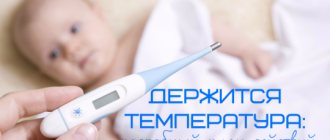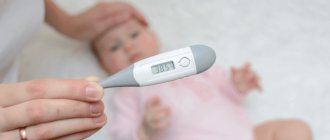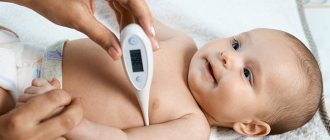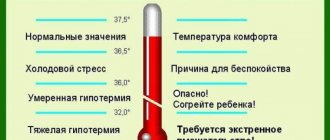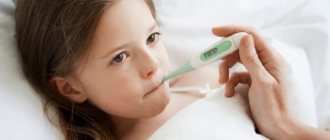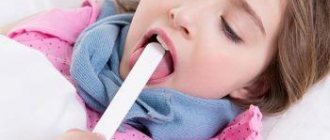Optimal temperature indicators in infants
After birth, the child’s body needs time to adapt to new living conditions. The normal temperature of a baby can vary from 36.2 to 37.2 degrees. In some children, heat exchange is formed by four months, in others a little later. Therefore, mothers do not need to worry when, instead of the usual 36.5, the thermometer shows 36.2 or 37.2. Moreover, during the day, body temperature can change within this range. An increase or decrease in temperature can occur for various reasons.
Factors influencing changes in body temperature in infants
- Dream. Since physical and nervous activity is reduced during sleep, body temperature can drop to 36.2 degrees.
- Wakefulness. During the waking period, the child is quite active. He twitches his legs and arms, raises his head, rolls over from his back to his tummy, laughs, cries. If you measure the temperature during this period, the thermometer scale can show a value of up to 37 degrees.
- Water procedures. After taking a bath, the body’s activity calms down and slows down - this helps lower the temperature to 36.2 degrees.
- Cloth. To maintain normal body temperature, it is important to choose the right clothes. In hot weather, the child should be dressed lightly to avoid overheating, and in low air temperatures he should be dressed warmly enough to retain body heat.
- Viral infections. A newborn may have a temperature of 37 when the body is overcome by a viral infection and the body temperature rises. This happens because the body begins to fight foreign agents. A decrease in indicators indicates recovery.
Temperature measurement methods
Remember that you should measure your baby’s temperature when he is at rest. If the baby cried or played actively, then it is necessary to wait for a certain period of time. Also note that when measuring while feeding, the thermometer reading will be slightly higher.
In the armpit
If your baby is not yet sitting on his own, then carefully place him on his back. Lift the handle up, carefully place the thermometer under your armpit and then lower it. Wait for the signal to complete the measurement with an electronic thermometer or wait 5 minutes with a mercury thermometer. If the baby can sit, then sit him on your lap with his back to your chest. Place the thermometer under your armpit and remember to lightly hold your baby’s hand the whole time until the end of the procedure.
Normal temperature in the armpit is 36.3ºC-37.3ºC
Rectally
Before starting the procedure, lubricate the end of the thermometer with baby cream. Place the baby on his back, grabbing his ankles and raising his legs. The thermometer must be carefully inserted into the intestine no further than a couple of cm. Wait enough time and remove the device. Particular care will be required when using a mercury thermometer. The baby may jerk, after which the glass may crack. In addition, it is necessary to disinfect the thermometer after each use.
Normal temperature in the rectum is 37.6ºC-38ºC
In the ear
You will need an ear thermometer. With careful movements, pull the earlobe back, lift it and place the end of the thermometer in the ear. Also carefully pull out its end of procedure field. You will have to be extra careful because using this type of thermometer can easily damage a child's fragile ear canal.
Normal temperature in the ear is 36.9ºC-38.5ºC
Oral
The only way to accurately determine temperature using the oral method is an electronic pacifier thermometer. Remember to disinfect it after each use. Many people use a regular thermometer, holding it in the child’s mouth at the required distance. This method of measuring temperature increases the risk of errors in the readings. You need to be especially careful if you are using a mercury thermometer and your baby’s front teeth have already erupted. It can easily bite through the glass, which can lead to irreversible consequences.
Normal temperature in the mouth is 37.1ºC
Physiological features
In an infant, a temperature of 37 has a connection with physiology, and in different months of life it is explained:
- Newborn. The body of a newly born child has not yet formed a thermoregulation mechanism.
- 1-4 months. During this period of life, the mechanism of thermoregulation is still imperfect. In addition, the baby is entitled to vaccination; after vaccinations, a slight increase in temperature is often observed.
- 5 months. Low-grade fever may be a consequence of improper complementary feeding. If, along with an increase in temperature, the baby experiences severe colic, flatulence and bloating, then the mother gave him protein food early.
- 6-7 months. A temperature of 37 in a baby means that teeth will soon erupt. It can last for more than a week until the baby tooth comes out of the gum.
The thermoregulation mechanism is fully formed by the age of 1 year.
Often a temperature of 37 in a baby is erroneous due to incorrect measurement, because in such babies it is difficult to measure the indicators with a regular thermometer. Better to use:
- pacifier thermometer - a device that helps parents find out the body temperature of even a sleeping child;
- ear thermometer: gives the most accurate and fastest results.
Rectal temperature measurement in children under one year of age is the most dangerous method. After all, it is impossible to keep the baby motionless for several minutes.
In order for the child’s thermoregulation mechanism to develop without failure, parents are advised to abandon the practice of constant swaddling. In this situation, the child’s body will not be able to adapt to the external environment in time.
What causes the temperature to rise
An increase in temperature is a consequence of some provoking factor. Children under 3 months of age should not lower their body temperature below 38.2 degrees. The thermoregulation process can be disrupted. But this is only if the baby feels relatively well. If convulsions appear, he becomes lethargic, or loses his appetite, you should consult a doctor.
The reason for the increase in temperature may be:
- Viral and bacterial infections. In this case, there will be other symptoms: cough, redness of the throat, runny nose.
- Stressful situations.
- Overheat. Long exposure to the sun, improper dressing.
- Active games or long crying.
- The cause may be teething.
- A high temperature may be the result of an intestinal infection or a cold.
- The temperature of children under one year of age may increase after vaccination.
In the event that an elevated body temperature persists for three days, if it reaches 39 degrees or higher and is not reduced by antipyretics, you should immediately seek medical help. When it’s hot, the body’s tissues stop receiving oxygen, and the defenses weaken, which is a very dangerous condition.
An ambulance should be called in cases where the following symptoms appear:
- A child under three months of age has a fever.
- The baby's temperature is above 38.5 degrees.
- Convulsions appeared.
- Tension in the cervical spine, it is impossible to bend the head forward.
- Breathing becomes noisy and frequent.
- The child constantly cries, while he is lethargic and apathetic.
- Refusal to eat.
- There is frequent vomiting and diarrhea.
- Problems with urination or urine color.
- The appearance of a rash on the skin.
- Presence of chronic diseases.
- Inability to reduce fever with antipyretics.
Before the doctor arrives, you should follow a few simple recommendations.
- The baby should be given as much fluid as possible.
- The children's room needs to be ventilated. The child should be moved to another place for this time.
- The light should be dim. No harsh sounds.
- You can apply compresses to your legs. The towel is moistened in water (about 20 degrees) and applied to the feet.
- You can't wrap up a child.
If children's body temperature decreases, but only slightly (up to 35 degrees) and they feel well, then there is no need to worry. Perhaps this is an individual characteristic of the body. If the value drops below 35, they speak of hypothermia. You should consult a doctor. He will order additional examinations. You will need to consult a pediatrician, endocrinologist, or immunologist.
Reasons for a decrease in body temperature in a child under one year of age:
- In children born prematurely.
- During sleep.
- Against the background of a long-term illness, the body’s defenses weaken.
- Vitamin deficiency, anemia.
- Hormonal imbalance.
- While taking antipyretic drugs.
- Malignant formations.
- Hypothermia.
- After severe poisoning.
If the decrease is associated with hypothermia, then the child should be warmed up (warm drink, warm clothes, you can apply a heating pad to the legs). It is important to harden and increase immunity.
How does the disease manifest if a newborn has a temperature of 37?
Symptoms and possible diseases:
- Cough is an allergic reaction to an external irritant; initial stage of bronchitis; cold; pneumonia; chronic tonsillitis.
- Runny nose - allergic rhinitis or cold.
- Vomiting is an intestinal infection; poisoning (with an adapted mixture or food); gastrointestinal diseases; disorders of the central nervous system (after injury or viral infection).
- Abdominal pain – acute viral respiratory disease (ARVI); infectious disease (measles or whooping cough); appendicitis; angina; intestinal infection; poisoning; entry of a foreign body into the stomach.
- Diarrhea is an intestinal infection; cold; parasite damage.
- Headache – any respiratory disease, flu, sinusitis, poisoning.
- Hoarse voice – flu, bronchitis, laryngitis, tracheitis, tonsillitis;, pneumonia
- Muscle weakness is the initial symptoms of a cold, ARVI or other causes that may indicate the onset of an infection or inflammation that has appeared in the body.
After a course of treatment with antibiotics, the baby may still have a temperature of 37. The main guideline in this situation is the baby’s mood. If it does not give cause for concern, then additional therapeutic measures will not be required. This symptom goes away on its own and cannot be corrected.
Antibiotics are powerful drugs that aggressively interfere with the life of pathogens. A temperature of 37 in a newborn after taking them is a side effect of the action.
If, against the background of elevated temperature, the child’s general well-being and behavior begins to deteriorate, then it is necessary to consult a doctor.
Folk remedies
As a folk therapy, you can try an old and effective method - wiping the child with clean water. The use of various herbs and other traditional medicines can be dangerous due to an allergic reaction. Rubbing with vodka or table vinegar often causes irritation of children's skin. Therefore, it is recommended to moisten a towel with water at room temperature and wipe the child’s face and body (especially the forehead, arms, legs, and stomach).
The disadvantage of this procedure is that it must be repeated every 15 minutes, since the temperature will rise to the previous level. For this purpose, it is advisable to place a basin of water near the crib.
Tips on how not to exceed a newborn's temperature of 37
In a newborn, a temperature of 37 may appear under the influence of external factors. Parents must protect their child from overheating and follow the rules:
- In a stuffy and hot room, the baby’s body temperature rises. Therefore, it is important to maintain the temperature in the room - no higher than 22-23°C.
- Children of any age should wear one more layer of clothing than adults. Even a sick baby should not be wrapped in a warm blanket - this can lead to heat stroke.
- When a child sleeps, his body temperature is lower than when he is awake. For this reason, it is necessary to prevent it from freezing at night. Children should be covered with a blanket made of natural (breathable) materials.
- Always wear a hat when walking. In children under one year old, colds are most often the result of hypothermia of the head.
- Provide your baby with a drinking regime, especially during the hot season.
- Under no circumstances should you leave your child alone in a closed car.
A mother can determine that her baby is cool just by touching the back of her head with her palm. If the back of your head is warm, then no additional clothing is needed.
The baby was born
All people are naturally endowed with a thermoregulation system. Body temperature is controlled by the hypothalamus. It regulates heat exchange and heat production and maintains a certain balance.
The baby is born with an unstable heat transfer system, and until 3 months it will not be able to independently maintain a stable temperature. Infants are very sensitive to changes in ambient temperature.
In the first minutes of life, the baby’s temperature is the same as that of the mother, then it drops by 1.5-2 degrees, and by the fifth hour of life it reaches 36.5 °C.
As you watch your baby, you will notice that his temperature is lowest in the morning and highest in the afternoon. To better understand what the normal temperature is for a baby, you need to remember that the temperature varies significantly in different parts of the body.
Indicators of normal temperature in infants
- Rectal 36.9-37.4 °C;
- Oral (in the mouth) 36.6-37.2 °C;
- In the armpit 36-37 °C.
There are also individual temperature fluctuations in a newborn, the norm is from 35 °C to 38.3 °C.
How is a baby's temperature measured?
- A mercury thermometer is used to measure only in the armpit. The baby will not be able to hold the thermometer on his own, so check everything yourself. Place the thermometer under the baby’s arm and hold it there for 3-5 minutes;
- The temperature indicator is measured by applying a strip with square markings or numbers to the forehead. But be careful! There are indicators that are placed under the tongue. Read the instructions carefully! Follow the exact recommendations of a particular indicator;
- An electronic thermometer measures temperature orally or rectally. The tip of such a thermometer is given to the child to hold in the mouth or not deeply (2 centimeters) inserted between the buttocks for one minute. You can lubricate the tip with cream. An electric thermometer usually signals the end, but not all thermometers have this function. During the entire procedure, hold the baby’s legs and hold the thermometer with your free hand.
Reasons for rising temperature
- Teeth are cutting through;
- High mobility;
- Constipation;
- The child cried for a long time;
- Individual feature;
- Overheating;
- Excessive wrapping;
- Fever (not a symptom of illness) due to lack of water in the body.
We noticed a white coating on the baby’s tongue, it does not necessarily indicate a disease, read here what a white coating means and how to cure it. Advice from pediatricians will help you deal with all the symptoms.
Signs of fever
- Thirst;
- Sweating;
- Rapid breathing;
- Rapid pulse;
- Excessive blushing or pallor;
- Chills;
- Inflamed eyes;
- Dry mouth, dry lips.
To be able to assess the indicators of rapid heart rate, you need to remember that:
- Normal heart rate during sleep is 100-130 beats/min;
- Normal pulse during wakefulness is 140-160 beats/min;
- When a child cries - 160-200 u/min;
- By the age of two, the pulse slows down to 100-140 beats/min;
- Normal respiratory rate is from 40 to 60 breaths per minute;
- In one-year-old children - 25-30 breaths per minute.
How should parents behave if their child’s condition worsens?
In any situation, parents must remain calm and observant. A slight increase in body temperature should not be a reason to panic.
If within several days the scale on the thermometer does not drop below 37 degrees, then you need to monitor the child and the possible manifestation of the clinical picture of the disease. They may include: cough, diarrhea, allergic skin rash. In such a situation, the child should be shown to a doctor. In case of a sharp deterioration in general condition (for example, vomiting), emergency medical assistance should be called.
- The use of antipyretic drugs at a temperature of 37 degrees is not recommended. The best way to remove intoxication products from the body is warm and plenty of fluids.
- Bed rest is not required.
- It is extremely important to ensure a flow of fresh air by frequently ventilating the room. If there are no contraindications from the doctor, you can take your baby for walks.
- The issue of bathing a child at a body temperature of 37 degrees remains controversial among doctors. Many pediatricians advise against taking a bath, especially if the child develops a fever. This can dramatically worsen the child’s condition. It is better to do with washing and partial washing.
- If the child is on complementary feeding, then at the moment there is no need to introduce anything new into the diet. Try to balance your diet at this point.
If, even after all the steps taken, the baby’s temperature is 37 and it does not decrease, then you should consult a doctor in order to undergo a full diagnosis and, if necessary, begin treatment.
Preventive measures
If, after a doctor’s visit to your home, it was diagnosed that a baby’s temperature of 37 is normal and no symptoms of the disease were detected, then you should still take some preventive measures to normalize the baby’s body temperature:
- maintain a daily routine;
- hardening the child;
- often take the baby for walks;
- constantly ventilate the apartment;
- create favorable conditions for good sleep;
- do not expose the child to stressful situations;
- When infections are detected, begin timely treatment.
- provide a favorable psychological atmosphere in the house.
How to properly reduce a baby's temperature?
You need to start lowering your temperature when it rises above 38.5 degrees. There are many methods and medications to solve this problem, but not all of them are approved for the treatment of newborns and infants. Antipyretic suppositories and syrups are produced especially for them.
The most gentle and effective way to reduce high fever is the use of rectal suppositories. Through the rectum, the medicine immediately enters the circulatory system and begins its effect, which lasts for a long time. Contraindications include only intestinal disorders.
Antipyretic rectal suppositories should be stored in the refrigerator.
The second dosage form is syrups. Many mothers are afraid to use suppositories and prefer antipyretic syrups for children. They affect the body for 4 hours. If the syrup causes nausea or vomiting in the child, it is better to use suppositories.
For newborns and infants, the use of drugs such as Paracetamol or Ibuprofen (same as Nurofen) is recommended. Paracetamol is not an anti-inflammatory non-steroidal drug like Ibuprofen. Its effect is limited only to lowering the temperature and providing a weak analgesic effect. Ibuprofen is used more for infections with severe inflammation.
Rubbing with vinegar or vodka is a folk method that has been used since ancient times to reduce high fever. But it is unacceptable for children at such an early age. Under the influence of aggressive substances, burns may form on the child's skin.
If you doubt the correct use of medications during an elevated temperature in an infant, it is better to consult with your doctor.
How to measure a baby's temperature
To understand how to measure a baby’s temperature, you need to know how many types of thermometers there are and which ones are the most effective and safe.
- A mercury thermometer is quite accurate. It also has an unlimited shelf life if stored properly. However, it is the most dangerous, because it contains mercury. If you break such a thermometer, you can get poisoned by mercury vapor. Another disadvantage of this device is the long waiting time for results, about 5-8 minutes. This thermometer is definitely not suitable for infants.
- Thermal strips are not the most common and not the most accurate device for changing temperature. It is a black film that needs to be attached to the baby’s forehead. When it comes into contact with warm skin, it changes color. This idea is worthy of attention, but, unfortunately, it is not finalized. The measurement result is influenced by many extraneous factors, lighting, tightness of attachment to the skin, whether the baby is sweating at the moment, etc. Therefore, the device often shows false data.
- Electronic thermometers are considered one of the best for young children. They are made from safe components, without glass and mercury. The temperature is measured by a special built-in sensor, and the results are displayed on the display. The accuracy of these thermometers is slightly lower than that of mercury thermometers.
- Pacifier thermometers are convenient for little toddlers. They work on the principle of electronic thermometers and are very easy to use. The baby does not suspect that this is a thermometer and does not experience any discomfort, unlike models that need to be placed in the armpit. The disadvantage of this model is that the child must continuously keep it in his mouth. If the toddler cries, the measurement data will be inaccurate. In addition, these devices are equipped with batteries that need to be changed periodically.
- Infrared thermometers can be forehead, ear and non-contact. It is believed that earplugs, which are used mainly for otitis media, give incorrect information. It is also worth remembering that frontal and ear models should only be used on the baby’s forehead and ear. Contactless devices are convenient because they do not need to be applied to the baby. The advantage of such thermometers is the high measurement speed, about 2-5 seconds. And although they may give a small error, if used correctly, it will be insignificant. The disadvantage of this device is its high cost.


